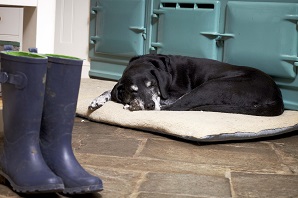Raw Diet Dogs No Proven Benefits
The pros and cons of a raw food diet for dogs

The latest issue of Petplan's PetPeople magazine featured an article by animal nutritionist Marge Chandler on the risks of raw food diets for dogs (scroll down to read it).
This article caused plenty of debate on our Facebook and Twitter feeds, with people in favour of the diet keen to point out its potential benefits.
To provide the other side of the story, we spoke to Liesbet Lester, a vet and advocate of the diet...
Liesbet Lester says:
An eminent zoo vet recently opened a raw feeding conference with these words: 'Given the large body of evidence in the zoo world on feeding carnivores raw food, I'm very surprised we need to persuade the veterinary profession in the first place.'
The veterinary profession remains suspicious because there is, as yet, little direct research on the safety and benefits of this diet. However, last year, the 79 vets from around the world who took part in a snapshot survey on raw feeding all commented favourably on its safety and benefits.
It's important to remain open-minded, but personally, I am absolutely an advocate. My Chihuahua, Tosca, was seven years old when we got him, and overweight. A raw food diet removes a lot of unnecessary carbohydrates, so it can be a great way of helping a dog to lose weight or maintain their condition. Tosca is now a thriving, healthy 11-year-old – we haven't had one problem in all that time.
Sourcing raw food
You do need to know that the raw food you choose is good enough for your dog. In the UK, vets and owners can easily source complete and balanced ready-prepared frozen raw food meals, formulated to the same European standards as the other pet foods we find in our supermarkets and veterinary surgeries.
High-quality prepared raw foods should come from Defra-registered producers. These foods are governed by more stringent bacteriological rules than even human-grade raw meat products, and are supplied in clean, easily understandable packaging.
The issue of bones
Bones are very contentious in the raw food debate because of the possibility of them damaging the mouth and digestive system. However, there is no data to show that they're dangerous, and vets' bad experiences are usually to do with cooked bones. Raw bones help clean teeth, and provide fibre, nutrients and entertainment. If for some reason a dog cannot cope with whole bones, most prepared raw foods contain 2 to 4 per cent ground bone.
I believe that correctly prepared raw food is complete and balanced, strictly controlled, safe to feed and convenient, with zero 'gore-factor'. But quality of diet is the most important thing. If you decide that raw feeding isn't for you, then the commercial dog food you buy needs to be the best you can get. It's the quality of diet, whether commercial or raw, that's the most important thing.
Marge Chandler says:
Feeding your dog a 'Barf' diet (which stands for 'bones and raw food' or 'biologically appropriate raw food') has become popular in the US in recent years, and now many UK pet owners are considering it too. Dog owners who support a raw diet claim that it promotes shinier coats and healthier skin, improved energy levels and fewer digestive problems.
Some working dogs and racing Greyhounds are traditionally fed a raw food diet, which typically consists of muscle meat (often on the bone), offal, whole or ground bones and sometimes raw eggs, fruits and vegetables.
However, no studies have been done to prove its health benefits, and I have seen too many injuries from dogs eating bones to recommend their use. It's not a diet many animal nutritionists support because of the various risks involved.
The right balance
A raw food diet is unlikely to be complete and balanced. Unless the dog owner is an expert in animal nutrition, a homemade diet can be difficult to get right – a dog needs 37 essential nutrients to stay in good shape, and balancing the correct amounts of zinc and iron, for example, is very tricky.
Purchasing pre-prepared raw foods is no guarantee of nutritional balance, either. Natures Menu is the only UK raw food supplier currently registered with the Pet Food Manufacturers Association, and thus required to comply with EU nutrient profiles.
Bacterial infections present another risk. Bacteria exist in raw human food too, but the difference is that we cook it. Although some dogs can ingest a small amount of salmonella safely, pets that eat raw food are likely to shed more pathogenic ('bad') bacteria in their faeces. And although responsible owners will pick up their dog's poo, you cannot remove every trace.
The harmful bacteria that remain could affect those vulnerable to infection, including young children, the elderly and those with a weak immune system.
Some pathogens in raw food can also cause vomiting and serious illnesses in dogs themselves. It's possible that some benefits of a raw food diet will be proven in the future, but for now it's not a feeding routine that I would recommend.
What do you think of raw food feeding for dogs? Do you have experience of it? Let us know below…
Back to top
Raw Diet Dogs No Proven Benefits
Source: https://www.petplan.co.uk/pet-information/blog/the-pros-and-cons-of-raw-food-diets-for-dogs/
0 Response to "Raw Diet Dogs No Proven Benefits"
Post a Comment